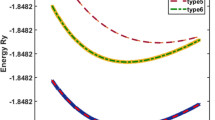Abstract
The mathematical formalism is studied for medium — foreign spherical inclusion models (in materials science) and body tissue — spherical tumor models (in oncology). It is established that they are similar, which is a frequently encountered phenomenon for general laws in mathematical descriptions of very different types of processes (for example, diffusion and thermal conductivity, electromagnetic oscillations and sound, statistical mechanics and population dynamics). A typical process occurring with powders in metals technology and nature is a complex process including diffusion and chemical reaction. Such a process sometimes relates to diffusion in the active medium. Special cells in the body (lymphocytes) appear outside tumors, move toward them, penetrate into them, and trap tumor cells. It is suggested that the lymphocytes can be considered as analogs of diffusing particles (the diffusant) while the tumor cells can be considered as analogs of traps in the case of diffusion in an active medium. An equation is also proposed that describes the behavior of an ensemble of tumor cells under the influence of a magnetic field.
Similar content being viewed by others
References
B. Ya. Lyubov, Kinetic Theory of Phase Transitions [in Russian], Metallurgiya, Moscow.
R. S. Subramanian and R. Balasubramaniam, The Motion of Bubbles and Drops in Reduced Gravity, Cambridge University Press, Cambridge (2001).
A. I. Raichenko, A. V. Byakova, S. V. Gniloskurenko, et al., “The behavior of a bubble surrounding an inclusion/gas source under the influence of capillary, hydrodynamic, and diffusion effects,” Poroshk. Meallt., Nos. 5–6, 14–23 (2005).
J. Crank, The Mathematics of Diffusion, Clarendon Press, Oxford (1956).
D. A. Frank-Kamenetskii, Diffusion and Heat Transfer in Chemical Kinetics [in Russian], Nauka, Moscow (1967).
A. H. Samuel and J. L. Magee, “Theory of radiation chemistry. II. Track effects in radiolysis of water,” J. Chem. Phys., 21, No. 6, 1080–1087 (1953).
A. H. Wilson, “A diffusion problem in which the amount of diffusing substance is finite,” Phil. Mag., 39, No. 288, 48–58 (1948).
H. S. Carslaw and J. C. Jaeger, Conduction of Heat in Solids [Russian translation], Nauka, Moscow (1964).
D. Allan, “The solution of a special heat and diffusion equation,” Amer. Math. Monthly, 63, No. 5, 315–323 (1956).
H. Fricke, “Track effect in biochemistry of aqueous solutions,” Annals of the New York Academy of Sciences, 59, Article 4, pp. 567–573 (1955).
H. Gaus, “Diffusion traps,” Z. Naturforsch, 20A, No. 10, 1298–1308 (1965).
H. P. Mundt and A. K. H. Richter, “Measurements of argon diffusion in potassium fluoride,” Z. Naturforsch., 20A, No. 2, 267–269 (1965).
R. Steinitz, Problems in Modern Metallurgy: Collected Papers [Russian translation], Izdat. Inostr. Lit., Moscow (1954), Issue 3, 149–157.
A. I. Raichenko, “Calculation of diffusion in a binary powder mixture of metals with limited mutual solubility,” Poroshk. Metall., No. 10, 43–46 (1968).
A. I. Raichenko, Diffusion Calculations for Powder Mixtures, Nauk. Dumka, Kiev (1969).
A. I. Raichenko, “Mathematical description of diffusion at the periphery of spherical particles,” Poroshk. Metall., No. 8, 19–22 (1980).
A. I. Raichenko, “Theory of diffusion of particles with a magnetic moment when exposed to a magnetic field,” Ukr. Fiz. Zhurn., 32, No. 1, 142–147 (1987).
P. F. Zdrodovskii, Problems in Infection, Immunity, and Allergy [in Russian], Meditsina, Moscow (1969).
C. DeLisi and A. Rescigno, “Immune surveillance and neoplasia. I. A minimal mathematical model,” Bulletin of Mathematical Biology, 39, No. 2, 201–221 (1977).
L. Kh. Garkhavi, E. B. Kvakina, M. A. Ukolova, et al., “Experimental and clinical study of the anti-tumor effect of magnetic fields,” in: Reports of the All-Russian Scientific and Practical Conference of Oncologists on Unconventional Methods in Oncology (September 23–26, 1991, Rostov-na-Donu) [in Russian], Rostov. Nauchn.-Issled. Onkolog. Inst., Rostov-na-Donu (1991), pp. 4–15.
A. K. Pankov, R. N. Salatov, and N. M. Kuz’mina, “Treatment of malignant tumors with a magnetic field,” in: Reports of the All-Russian Scientific and Practical Conference of Oncologists on Unconventional Methods in Oncology (September 23–26, 1991, Rostov-na-Donu) [in Russian], Rostov. Nauchn.-Issled. Onkolog. Inst., Rostov-na-Donu (1991), pp. 68–75.
Author information
Authors and Affiliations
Additional information
__________
Translated from Poroshkovaya Metallurgiya, Nos. 11–12(446), pp. 72–78, November–December, 2005.
Rights and permissions
About this article
Cite this article
Raichenko, A.I. Comparative analysis of one-particle mathematical models in materials science and oncology. I. Mathematical models. Powder Metall Met Ceram 44, 578–582 (2005). https://doi.org/10.1007/s11106-006-0028-7
Received:
Issue Date:
DOI: https://doi.org/10.1007/s11106-006-0028-7




